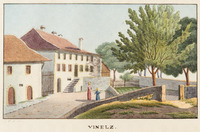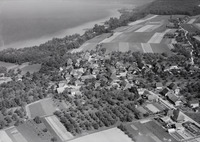Vinelz facts for kids
Quick facts for kids
Vinelz
|
||
|---|---|---|
|
||
| Country | Switzerland | |
| Canton | Bern | |
| District | Seeland | |
| Area | ||
| • Total | 4.56 km2 (1.76 sq mi) | |
| Elevation | 460 m (1,510 ft) | |
| Population
(Dec 2020 )
|
||
| • Total | 878 | |
| • Density | 192.5/km2 (498.7/sq mi) | |
| Postal code |
3234
|
|
| Surrounded by | Brüttelen, Erlach, Ins, Lüscherz, Twann | |
Vinelz is a small town, also called a municipality, located in the Seeland area of the canton of Bern in Switzerland. It sits on the right side of Lake Biel and stretches towards the bottom of the Schaltenrain mountain. Vinelz is known for its beautiful lakeside setting and its long history, including ancient settlements and a special church. Today, it's a popular spot for tourists, with campgrounds and a marina.
Contents
History of Vinelz
Vinelz was first written about in the year 1228, when it was called Fenis. For a while, it was also known by its French name, Fenil, but that name is not used anymore.
Ancient Settlements and Roman Times
Long ago, during the Neolithic (New Stone Age) and Bronze Age, many people lived along the shore of Lake Biel in this area. Evidence of these old settlements has been found here and in the nearby town of Lüscherz. An even older settlement from the Early Bronze Age was found inland at a place called Schattewil. Later, during the Roman times, people also lived in Vinelz, with Roman settlements found at Mieschzälg and Flachseren.
Vinelz in the Middle Ages
During the Middle Ages, Vinelz was part of the Herrschaft (a type of territory ruled by a lord) of Erlach. In 1474, the city of Bern bought all the lands belonging to Erlach, including Vinelz. After this, Vinelz became part of a new area managed by Bern, called the bailiwick of Erlach. In 1691, a citizen from Bern named Emanuel Gaudard built a large country house, called the Landsitz Obere Budlei, in the village.
The Village Church
The village church of St. Mary's was first mentioned in 1228. It was likely built by the Counts of Fenis, who ruled from the nearby Fenis or Hasenburg Castle. In the 14th century, the church was decorated with beautiful murals (wall paintings), and it was rebuilt in 1484. After the Protestant Reformation in 1528, the rights to control the church (called patronage rights) were given to Bern. The church in Vinelz also serves the nearby town of Lüscherz.
Vinelz Today: A Tourist Spot
In the 1960s, many new vacation and weekend homes were built in Vinelz. This changed the town from mainly farming to a place focused on tourism. Today, Vinelz has restaurants, three campgrounds, and a marina, making it a popular tourist center on Lake Biel.
Geography and Landscape
Vinelz covers an area of about 4.6 square kilometers (1.8 square miles). A large part of this land, about 51.6%, is used for farming. Forests cover about 35.4% of the area. The remaining land, about 14%, is where buildings and roads are located.
The town of Vinelz includes the main village and the farmhouses of Budlei. On January 1, 2010, Vinelz became part of the newly created Verwaltungskreis Seeland, which is a new administrative area.
Vinelz Coat of Arms
The coat of arms for Vinelz shows a blue shield with a silver sickle (a tool for cutting crops) and a silver plowshare (the cutting part of a plow). The sickle has a golden handle. These symbols likely represent the town's history in agriculture.
Population and People
Vinelz has a population of 878 people. About 8.8% of the people living in Vinelz are foreign nationals. Over the past ten years, the population has grown by about 10.9%.
Languages Spoken
Most people in Vinelz speak German as their main language, about 92.1% of the population. French is the second most common language, spoken by about 5.3% of the people. A smaller number of people, about 0.8%, speak Albanian.
Population Changes Over Time
The chart below shows how the population of Vinelz has changed throughout history:

World Heritage Site
Vinelz is home to a very special place called the Strandboden prehistoric pile-dwelling settlement. This site is part of the Prehistoric Pile dwellings around the Alps which is a UNESCO World Heritage Site. This means it's recognized by UNESCO as being very important for everyone in the world to protect.
Discoveries at Strandboden
The Strandboden site was used a lot during the Neolithic period. Scientists used tree ring analysis to find out that people lived there at different times, including around 3160 BC, 2850 BC, and 2750-2690 BC. The site was first found and explored in 1881-1882. One of the most exciting discoveries was a disc wheel from about 2750 BC.
Important Heritage Sites
The Ländti site, which is a settlement from the Neolithic and Bronze Age found by the lake, is listed as a Swiss heritage site of national significance. This means it's a very important historical place for Switzerland. Also, the entire village of Vinelz is part of the Inventory of Swiss Heritage Sites, showing its overall historical value.
Economy and Jobs
In 2011, the unemployment rate in Vinelz was low, at 1.46%. In 2008, there were 140 people working in the municipality.
Types of Jobs
- Primary Sector: 40 people worked in farming and related businesses.
- Secondary Sector: 42 people worked in industries like manufacturing and construction.
- Tertiary Sector: 58 people worked in services, such as sales, transportation, hotels, restaurants, and education.
Many people who live in Vinelz travel to other towns for work. In 2000, about 288 people left Vinelz for work, while only 65 people came into Vinelz to work. Most people used a private car to get to work, while about 10.3% used public transportation.
Religion in Vinelz
Based on information from 2000, most people in Vinelz belong to a Christian church. About 78.6% were part of the Swiss Reformed Church, and 12% were Roman Catholic. A small number of people, about 0.95%, were Islamic. About 6.67% of the population said they did not belong to any church.
Education in Vinelz
In Vinelz, many adults have completed higher levels of education. About 43.3% of the population has finished non-mandatory upper secondary education, and 16.5% have gone on to complete university or a specialized college.
School System
The Canton of Bern has a school system that starts with one year of optional Kindergarten. After that, students go to six years of Primary school. Then, they attend three years of lower Secondary school, where students are grouped by their abilities. After lower Secondary, students can choose to continue their education or start an apprenticeship (on-the-job training).
During the 2010-2011 school year, 64 students attended primary school classes in Vinelz. There were no kindergarten classes in the town.
See also
 In Spanish: Vinelz para niños
In Spanish: Vinelz para niños









